#днявочка: hlegacy
Explore tagged Tumblr posts
Text
#1545: Hogwarts Inquires – 138
Back on the Path & Charles’ Rookwood Trial
Инквари, которая должна была появиться ещё с год назад, но с тех пор утекло так много воды, что я уже не уверен, играю ли я в оверпрайснутый симулятор ходьбы или выкапываю такие бездны знания, о которых не существует даже упоминания в открытом Интернете. Например, откуда Рудольф Кох взял некоторые символы для своей «Книги символов» и существуют ли какие-то интересные исследования на тысячи страниц про эволюции старых латинских монограмм в монограммы торговых домов, гильдий и лавочек средней и северной Европы.
Интернет мне сказал, такие магистерские диссертации ещё не написаны.
К тому же, я скажу вам сразу.
Я забыл всё связанное с данным квестом.
Но я помню, что писал перед тем, как за него взяться. Приводить полную справку не буду, думаю, краткой хватит, чтобы тезисно обозначить, с какими вводными мы зайдём в Руквудский замок:
Ашвайндеры и Лоялисты работают сообща, но в долине об этом вряд ли подозревают. Местные определяют эти фракции как работающие параллельно, при этом обе идентифицируют как бандитов, а не то, чем они сами себя называют. Ранроку выгодно такое положение дел, ведь какие-то ограбления корованов можно списать на Ашвайндеров. Руквуд союзу не рад, но ему срочно нужны ресурсы репо и сильные союзники, пусть и временные;
Местные жители либо зашуганы, либо соучаствуют. Такие, как Натти, пытаются бороться, но сталкиваются с тем, что какие-то действия могут быть поняты Ашвайндерами, как эскалация — повод убить кого-нибудь в качестве последнего китайского предупреждения. А такие, как Себастьян, настолько преисполняются ненавистью, что не ищут не просто какого-то диалога — сесть и подумать становится для них непосильной задачей;
Офицер Сингер, единственная действующая представительница закона в регионе, не работает работу. По какой именно причине и насколько на самом деле необоснованным является её постоянные требования найти ещё каких-нибудь доказательств (не только от Натти она их требовала) мы тоже в общем-то не имеем понятия, что, конечно, говорится отнюдь не в защиту её компетентности;
Ситуация с Анной Саллоу окутана мраком, который, в общем-то, выгоден и Ранроку, и Руквуду, несмотря на потенциал для обостре��ия гоблино-волшебных отношений. Так было сказано: если влезешь, убьёт, и хорошо, если не насмерть. Кто именно её проклял тогда не имеет значения, но мы-то знаем, что Руквуду было незачем, а вот Ранроку было необходимо продемонстрировать силу. Об этом ниже;
Ищущие да необрящущие Лоялисты умудрились пробурить в репо, но всё равно не смогли разгадать секрет зачарованного зеркала, которое зачем-то оставили нетронутым. Подумывали спереть, продать? Не суть как важно, но древнемагией они не владеют, и это главное, что в принципе следует вынести из их кажущейся недальновидности. Ранрок, соответственно, тоже древнемагией не владеет, но может контролировать что бы в репо такое ни находилось;
МС и Фиг пребывают в Руквудский замок днём 31 октября 1890го года.
Начинается квест с похода в Ландкартный зал.
Фиг делится наблюдениями об обучении МС магии. Заострять на этом внимание не хочется, но стоит оговорить один момент.
То, как МС чувствуется, как аватар воли игрока, не то же самое, что персонаж МС.
Этот персонаж боится темноты и инфери, не любит пауков и любит шоколад, не слишком заинтересован в учёбе, судя по катсценам (на Зельях в уголочке стоит спит, например), но всё равно в достаточной мере эрудирован и начитан, чтобы знать про слово magnanimous и цитировать Лавлейса.
Так что то, что Фиг хвалит МС, это лорное указание на её способность к магии — и то, как лихо МС ею научается. Не без приколов, впрочем, вспомните описание квеста DADA Class:
I attended Defense Against the Dark Arts class. It went well. I learned a new spell, Levioso, the Levitating spell. Then I learned how to use Levioso to break an enemy's magical shield. On top of that I participated in my first duel and I'm honestly the natural talent. Perhaps I should give that unofficial duelling club a try?
Подобное отношение к своим способностям редко способствует совершенствованию навыков, о чём, кстати, может сказать некоторый профессор Шарп:
I'd advise doing more than the bare minimum if you want to hone your skills as quickly as possible. Talent and resolve are a potent combination. It would be a shame to let that go to waste.
Он может быть конечно и не прав. Он судит по интонации. Препод его уровня сочтёт логичным, что хамское отношение студента — признак зазнайства и, вполне вероятно, наплевательского отношения к учёбе.
Отношение МС к учёбе в целом выражается в постоянных вопросах о том, зачем же ей больше домашних заданий, а другие персонажи, вроде Поппи, как бы невзначай упоминают: если хочешь что-то узнать, иди в библиотеку. Требовать с МС сходу разбираться в незнакомой теории при том, что магия и волшебные штуки её очаровывают и уводят от учёбы, мы не станем, но и не будет преувеличением сказать, что Фиг несколько переоценивает МС, как студентку. Этот студент — распиздяй. Ну прямо как ёрс трули. :3
Чарльз и Персиваль разделяют энтузиазм Фига, но и нам понятно: соглашаются они с Фигом с большой натяжечкой и скорее констатируют факт, чем действительно интересуются успехами МС в учёбе.
Ещё из интересного: МС общается с Лодгоком в середине октября, но Фигу сообщает об успехах только под конец месяца. Вопрос: насколько МС и Фиг разделены во времени и пребывании, чтобы не сообщать друг другу всякие информации не в течение двух бизнес-недель.
А теперь, дорогие подпишеки, моя Священная Римская империя: знал ли Чарльз про репо. Оказывается, да, знал:

А я что-то думал, что не знал — или, господи прости, блядь, а про что вообще был вопрос?
Какой вопрос, спросите вы. А я уже не помню.
Год назад я вёл с кем-то дискуссию про припрятанный в замке репо. Точно помню, что на тот момент я не мог ничего, по существу, ответить, поскольку не помнил многих деталей про этот квест, но собеседник считал, что помню-знаю. То ли обсуждали мы, знали Киперы про репо вообще, то ли почему Исидора чего-то там. Не помню. Забыл. Не силюсь больше вспоминать.
Будем посмотреть, будем поизучать, понаблюдать, поскольку вопрос, наверное, мог состоять и в том, когда Чарльз узнал про репо: до или после смерти Исидоры. Что-то мне подсказывает, после, но я уже ни в чём не уверен going forward, ведь ну уж очень плохо помню вторую половину игры, чтобы как-то особенно смешно нащитпостить, не насрав себе полные штаны при этом.
Сказав Чарльзу, что вокруг замка творится настоящая свистопляска с пиздахаханьками да смехуечками, МС и Фиг незамедлительно отправляются в замок по его настоянию.
Про его устройство напишу в каком-нибудь другом посте, но скопирован он с замка Чепстоу, Уэльс, как мне было подсказано @the-magiarcheologist.


Прикрепил картинки, чтобы объяснить данный проёб в обороне замка:


Неудивительно, почему Чарльз из него съехал. Атакующие не станут пытаться протаранить ворота: они сбоку наставят лестниц, ещё и осадные орудия приволокут вместе с осадным лагерем на этот внушительных площадей задний дворик. Так отведут солдат от барбакана, и пока те пытаются разобраться с внезапновойском человек на пятьсот, ворота снесут и нафлудят в гостевой пройдут во внутренний двор и сломают двери в пал��ты лорда.
Какому-нибудь волшебнику или волшебникам тоже будет проще просчитать высоту и силу прыжка у ровной стены, чем пытаться катапультировать себя с земли. Гоблинам, соответственно, тоже упрощается задача: не лестницу строить, а посчитать, сколько нужно гоблинов, чтобы взобраться на стены.
Чем этот замок отличается от настоящего Чепстоу.
Вэлшский оригинал — заложенный ещё при Вильгельме Завоевателе мотт и бейли на очень удачной географии. Скалистый берег реки легко фортифицировать, что и было сделано, а получившийся склон, как видно на первой фотографии, достаточно крут, чтобы перенаправить средневековые войска к барбакану. Зачем это делалось, думаю, понятно: гораздо легче обороняться, когда маршрут атакующего войска легко просчитать.
Шотландские же замки нередко возводились на островах и скалах. Примеры:
Эйлин-Донан:

Даннотар:

Килкурн (который вы можете знать по знаменитой фотографии):


Все эффективно используют географию, а иначе и не могли: возвести замок стоило больших денег, тем более во времена, когда ещё имело смысл использовать замок не только как резиденцию, но форт.
К тому же, замок — это необязательно именно крепость, как мифический Камелот. Это, вообще-то, фортифицированное имение. Иногда оно должно просто выглядеть устрашающе.
Если цель построить именно имение, главная угроза которому голодные крестьяне с вилами, я не вижу целесообразности в строительстве аж куска Чепстоу на горе в отдалении от воды в регионе, где не шло и не могло идти маггловских войн при том, что в долине достаточно peel towers и башен, достойных настоящих волшепников.
Достаточно было просто построить огромную дуру, повторив трюк Вильгельма Завоевателя при завоевании Лондона.
В самом Лондоне Вильгельм не строил замков. Но зато замки спешно возводились в окрестностях города, заключая его в кольцо неприступных крепостей.
Если, конечно, стояла цель кого-то запугать или впечатлить. Или деньгами помахать. Но это же расточительство какое-то, и если не материалов[*], так усилий.
[*] — Чарльз всё-таки был профессором трансфигурации в Хогворце и его не зовут шотландским или вэлшским именем, да и Чепстоу никогда не был именно вэлшским замком. Его построили для возможной обороны Глостершира поскольку королевства Уэльса во времена Вильгельма очевидно не входили в состав англо-саксонских королевств и соответственно не могли войти в территориальный состав Англии (такое положение дел сохранится вплоть до 16го века).
Что-то, дорогие подпишеки, у меня всё очарование слетело.
Давайте я прекращу данный тангент.
На подходе к стенам замка можно услышать разговор следующего содержания:
ххх: Absurd, isn't it? Ranrok wants us to find the child, but – which child? yyy: We could take every child we find to Ranrok. Eventually we may get the right one. ххх: (exhales) Sounds a lot of work. Perhaps we just tell him we looked. If he asks. yyy: That does sound easier. Let's do that.
Я называю Ранрока и Руквуда комедиантами неспроста. Ну разве это не великолепно? Поди найди кого не знаю кого, где не знаю где, как не знаю как.
Посчитаем фраги.
Снаружи замка: 5 Лоялистов и 1 Ашвайндер. Всех можно обойти.
Loyalists: 43 (5). Лоялистов получило пизды: 28 + n. Ashwinders: 12 (6). Ашвайндеров получило пизды: 19.
На подходе к небольшой платформе спавнится арбалетчик и ещё один Лоялист. Обойти их нельзя.
Loyalists: 43 + 2 = 45 (5). Лоялистов получило пизды: 28 + n. Ashwinders: 12 (6). Ашвайндеров получило пизды: 19.
По проникновению за стены замка начинается, пожалуй, самая интересная катсцена в игре.
Всё такое вкусное, не знаю, с чего начать. Я её смотрел год назад, щас буду как в первый раз удивляться. Готовьтесь.
Victor: If I’d known your plan was to dig up half the country– Ranrok: I wouldn’t have to dig if you could simply bring me the child. [1] V: We wouldn't need the child if you hadn't sent a dragon to retrieve the container I spent months and countless Ministry favours tracking. R: You let board the carriage. My options were limited once I knew it would be inconveniently beyond my reach at that infernal school. [2] V: Have you not acquired enough power here? I allowed you to tunnel under my family home– R: ALLOWED ME? You are here only because you are descended from a ‘Keeper’ and may at some point inadvertently become valuable. We had an agreement. I will share the power that I discovered if you locate the stores of magic that are yet to be found. [3] So, unless you want another demonstration of my power — a power you one day hope to wield — bring me the child.
Нас пока не волнует всё сказанное про Чарльза и дракона, но нам очень интересно послушать про так называемые stores of magic и another demonstration of power.
В 110 я излагал краткую версию того, как была проклята Анна Саллоу. Здесь я хочу расширить её до более-менее точного таймлайна, сдать все явки и пароли и тем сформировать дежурную версию даже не столько её проклятия, сколько условий договора о сотрудничестве между Руквудом и Ранроком. Итак.
В 36 я писал, что смерть Мириам и проклятье Анны случаются как события одно за одним и приходятся на Пасхальные каникулы 1890го года; даты с 1 по 13 апреля. Ранрок убивает Мириам — и Ранрок же проклинает Анну боком об забор в качестве демонстрации Руквуду новополученных сил. Демонстрация была нужна по условиям сделки.
Какой сделки?
Ранрок знает и про Хранителей, и про Исидору, и про репо, и про магию, в нём заключённую. Однако Ранрок не обладает способностью Исидоры и не в курсе, где искать все эти stores of power — будь то другие репо (он же не знал, что их всего два) или траялы, не так важно. Он не знает, где все эти локации находятся, исходя из описаний Брагбора, да и местность он знает плохо.
Однако ей мог обладать Руквуд — Ранроку бы пригодились его связи, люди, знания, да вообще всё, на самом деле. Волшебникам, тем более местным, таким, как Катрин Хаггарти, могло не составить труда найти какие-то пещеры, камни, дома, замки. Если Себастьян смог нагеогессить, что именно было на триптихе изображено, то несколькотомный дневник наверняка упоминал какие-то конкретные поселения, ландмарки и прочие интересные топонимы.
Каким уж образом Лоялисты связываются с Ашвайндер��ми, не слишком понятно, но да и не суть как важно: Виктор, как и многие другие волшебники, гоблинов терпеть не может. Вполне возможно, что их присутствие на фамильной земле подожгло ему жопу и принесло на второй космической сразу в замок. Мы не знаем. Знаем только, что Ранрок показал ему и репо, и вот это:

Виктор наделал в штаны от перспектив обрести вундервафлю (вероятно потому, что в ОПГ разлад, 121) и согласился помочь Ранроку с поисками неких stores of magic [2].
Под ними понимаются скорее всего траялы, а не репо (мы видим Лоялистов именно вблизи траялов либо локаций вроде peel tower у Верхнего Хогсфильда). Исидора ведь успела заказать только два, и один Ранрок случайно нашёл сам, а тот, что под Хогворцем, мог так и не найти, если бы не долбоебизм Лодгока.
На момент отбытия Анны в Больничное крыло сделка Ранрока и Руквуда уже в силе.
Тогда же, согласно 36, Ашвайндеры наводняют долину Хогворца.
Про half the country [1], кстати, Виктор, скорее всего, не преувеличивает: мистер Алби Викс упоминает, что на торговых путях постоянно случаются ограбления корованов — раз; два — Ранрок материализуется в Гринготтсе и имеет там своих агентов. Значит, дневники Брагбора упоминают довольно много локаций (убежища Исидоры, кстати, тоже, и Лоялистами там кишит), которые проверяются Виктором, а затем туда выдвигаются отряды Лоялистов с бурами.
К началу игры время для Фига и МС выигрывает исключительно то, что Ранрок не может ощущать дым с древнемагическим приколом, а текст дневников у него изначально не весь.
К тому же, в данной катсцене Ранрок Виктора немного наёбывает.
[3] — вот условия их сделки. На какого-то child из [1] они не договаривались. Child появился поздне��, после ситуации в Гринготте, так ещё и Ранрок не удосужился хоть кому-то рас��казать, как данный child выглядит и зачем нужен и откуда вообще взялся. Виктор его ведь сразу спрашивает в начале игры: Who is this child? What are you not telling me?
Необходимо дополнить его вопрос тем обстоятельством, что Ранрок провафлил всё выступление с троллем, в то время как Виктор исполнял на бис мем «стою ахуел».
У меня теперь закрадывается впечатление, что Ашвайндеры из квеста Trials of Merlin в принципе могли уговорить МС на встречу с Руквудом, и МС даже могла вернуться с неё целой и невредимой, так ещё и наебать Руквуда, и Ранрока в придачу, отдав уже пустой фиал и напиздеть что-нибудь про воспоминание ни о чём. Такое вот bygones truly be bygones и no hard feelings, да и поймите, мистер Руквуд, Ранрок ведь убил Мириам Фиг, профессор Фиг не мог не отреагировать.
🤭🤭🤭
Вот это было бы трололо/10. Но увы. Имеем великое противостояние четырёх хлебушков.
Но тут, кстати, замечание надо сделать: Виктор мог догадаться, что МС этот ларец спиздила [2] — ну и тролль не мог не натолкнуть его на какие-нибудь интересные мысли. Может, конечно, он понял. Или ему похуй плюс похуй. Но скорее нет. По взгляду видно, что сказать что-то супротив Ранрока не может, вот просто все оскорбления проглотил (особенно вот это: and may at some point inadvertently become valuable), ультимативно затерпел, убегал из замка, едва сдерживая бугурт.
Плохи дела в ОПГ, плохи. Если какой-нибудь условный Селвин узнает про великий PWND от какого-то там гоблина, Руквуду — пиздец. Харлоу, скорее всего, тоже бы задался вопросом, стоит ли признавать авторитет Виктора или столкнуть его нахуй и прибрать себе к рукам всю ОПГ. Ну и к слову вот.
В файлах игры упоминается какой-то там переворот-раскол, организованный Селвином. Вполне вероятно, что уровень претерпевания Виктора в какой-то момент должен был стать известен, да даже и в том, что от изначальной игры дошло до релиза, его позиция главного в ОПГ кажется весьма шаткой. Посудите сами: договорился о чём-то с гоблином, за дисциплиной не следит (письмо Манфреда к Астрид), решение сотрудничать с Лоялистами Ашвайндерами при��ято без энтузиазма, тратит время хуй разберёшь на что, пытается поймать какую-то студентку. Замысел неясен, так ещё и местные расследования какие-то вести стали, ещё и гиппогрифов школьники спиздили, а потом арену для драконьих боёв сожгли вместе со всем, что там было, нуэточоваще.
План с драконом… Я не понимаю, где произошло недопонимание, но из того, что я сейчас прослушал… Ранрок думал, Виктор заколдует кэб? Виктор считал, что ларец, наверное, сам как-нибудь вывалится из окна? В какой-то момент появляется дракон — подобрать ларец? — но вместо демонстрации ума (как в Poached Egg) происходит красивая катсцена со съеданием Озрика, травмированием МС и эффектным примерно всем, только бесконечно бестолковым. План остаётся не понят даже с учётом того, что обоим было похуй плюс похуй на судьбы Фига, МС и Озрика.
Итак, теперь очерёдность событий вкратце:
Ранрок находит и читает дневники Брагбора. В них говорится о некоей силе, и великий ливарюционер Ранрок проникается идеей во что бы то ни стало её найти. =>
Собрав какое-то неопределённое количество гоблинов под своим началом, он отправляется в Руквудский замок. =>
Примерно в это же время Мириам Фиг изучает Фельдкрофт и окрестности по наводке некоего Источника. В 135 я писал, что этим Источником скорее всего является портрет Мерлина — но только если мы считаем, что Magic Awakening и Hogwarts Legacy существуют в одной вселенной. =>
Однако этим источником мог являться и уничтоженный на момент осени 1890 портрет Исидоры (и Чарльз намекает, что не совался в замок именно потому, что боялся, что его портрет будет испорчен). Уничтожен не Лоялистами, но пожаром. =>
Когда Мириам прибывает в замок на Пасхальных каникулах, Лоялисты потихоньку появляются в округе. Лодгок встречает Мириам. =>
Смерть Мириам от руки Ранрока. =>
Договорнячок с Руквудом пока ещё не вступил в силу. =>
Ночь проклятья Анны Саллоу. Вряд ли она была намеренно выбранной жертвой. Но Виктор получил свою демонстрацию и согласился помочь Ранроку в поисках неких stores of magic (и успешно идентифицировал местоположения большинство из них). =>
Апрель 1890 — Лоялисты и Ашвайндеры организуют союз и наводняют долину, крадут всё, что к полу не приколочено, а всё приколоченное уносят вместе с полом.
Теперь можно и в сам траял поиграть. Но перед этим, чтобы два раза не вставать, небольшой тангент про Infamous Foe данной локации — Белгруфа Череполома / Бладжеонера.
Игра про него пишет:
Now known for his militant approach to goblin rights, Belgruff the Bludgeoner was once a peaceful member of the goblin rights movement. It is said that the taste of power he got being around Ranrok convinced him to change his ways.
Сила ресентимента, вы хотели сказать.
Собранная в репо магия — это боль. Pain. Pain необязательно подразумевает именно апатию или именно плаксивость, именно такую вот экзальтированную вещь в себе, выглядящую жалко, но просто и понятно. Но ведь месть, ревность, ненависть, горечь утраты, скорбь, попранная честь, унижение, беспомощность, отчаяние — это всё тоже pain и у разных людей pain выражается очень по-разному. Не все скорбящие будут плакать. Не все ненавидящие будут махать кулаками. Не все живущие в печалях всяких разных унижений апатичны и рыдают в три ручья, могут и нагрубить, и ударить, и убить насмерть.
Мне сложно запинпоинтить, как бы точно описать, что именно вдохнули Лоялисты, но если вы когда-нибудь падали в состояние лютой беспомощности — обыкновенное ощущение при любом депрессивном расстройстве — вы понимаете, о какой именно заразе идёт речь.
Это когда у вас одномоментно что-то пропало или у вас что-то силой отобрали, вы это поняли разумом, но потом на вас накатило. Вот это вот животное отчаяние, от которого выть и лезть на стены хочется, из-за которого тащишься к психиатру, а то и не хочешь жить вовсе, но всё равно ползёшь, хотя бы назло, потому что организм умирать не хочет; можно и без психиатра. Вот эта вот скотина эмоциональной печали, совсем на печаль не похожей, странная апатия, при которой сохраняются силы двигаться дальше, но рано или поздно сжирающая душу, за неимением слова получше, и отбирающая любую волю не просто к существованию, но любым надеждам и новому в жизни (часто наблюдается в картине клинической депрессии), суть есть древнемагический джанк. Куски души, оторванные от неё, как куски рваной раны.
Ранрок, когда его вдохнул, законсервировался в своей ненависти, а Белгруф оскотинел, поскольку в любом борце за права всегда сидит животное, которое хочет разорвать ��прессора и развесить его на ближайшем дереве. Я очень сомневаюсь, что райтер, тронувший эту тему, на хоть каком-то уровне, кроме базовой логики повествования, осознаёт, куда именно решил влезть и как с этим работать. Я не просто так который раз упоминаю, что ливарюции писать непросто, и что процесс не чёрно-белый, и что в принципе такая вот вилланизация ливарюции в угоду логике откровенно сказочного повествования тоже выглядит, ну… Плохо и неинтересно/10.
Свита Белгруфа насчитывает 5 Лоялистов.
Loyalists: 45 + 5 = 50 (5). Лоялистов получило пизды: 28 + n. Ashwinders: 12 (6). Ашвайндеров получило пизды: 19.
О подсчёте фрагов из квеста. По какой-то причине, когда я проходил ради катсцены, у меня не получилось обойти спавнпоинт Ашвайндера-экзека и мне показалось, что по стелсу тут нельзя пройти. На второй раз (переигрывал ууже ради свиты Белгруфа) получилось. С чем это связано, непонятно. Учитывать эти фраги — которых получилось бы 7 Ашвайндеров и 4 Лоялиста — я не буду. Итого имеем:
Loyalists: 50 (5). Лоялистов получило пизды: 28 + n. Ashwinders: 12 (6). Ашвайндеров получило пизды: 19.
МС и Фиг спускаются на нижние уровни данжона. Там — следы бура. Откуда с поверхности был совершён прокоп, судя по яркому свету из пролома, не слишком понятно. Нигде в скалах снаружи нет таких трещин. Судя по направлению движения, Лоялисты просто решили бурить в ближайшую стену.

Репо от внешнего мира должен был защищать несколькодесятметровый слой скалы:

Зная местную архитектурную мысль, в стене был предусмотрен какой-то проход, скорее всего — широкий коридор. Вероятно, спрятанный за какой-то магической стеной, а то и древнемагуйской дверью (но и оставлять проход в этот подвал за выбивающейся по стилю древнемагуйской дверью, конечно, отвлечёт все подозрения, да; Мириам точно её видела, я уверен). Он вёл к помещению, где Чарльз оставил проход на траял.
У меня к этому решению, конечно, возникли вопросы. Например, как было устроено хранение репо изначально и понимали ли Чарльз и Персиваль, что их древнемагуй непременно наткнётся на источник магического говна и спросит, а что это такое и что с этим делать.
Резон Исидоре там прятать репо мне понятен. Толстая скала, добраться сложно, неочевидно, особенно на момент 15го века (вопрос вдогонку: Исидора знала про план Персиваля с траялами, но не перепрятала репо, и вот почему? Мелкий репо изначально задумывался, как часть тряла?).
Но в 19м веке происходят данные приколы, а я ведь даже не упоминаю про мародёрство. Оставленные без присмотра хозяев замки не только под воздействием погоды разрушались: их активно грабили, сжигали, а то и намеренно сносили.
Фиг подозревает, что репо это и есть the store of magic.
Я имею немного возразить: судя по расположению Лоялистских стоянок, данный термин следует понимать скорее как «все места на карте Хогворца и окрестностей, упомянутые в дневниках Брагбора». Я повторю: это необязательно именно репо. К тому же, вспомните, что Персиваль говорил про свой траял. Reservoir of Ancient Magic. Я понимаю, из чего исходит Фиг, но поскольку мы существуем над нарративом и сюжетом игры, нам понятно, что репо и stores of magic это не совсем пересекающиеся понятия.
В стене до сих пор шумит бур. Ы. Лоялисты на хайпе спрыгнули с него, когда увидели репо, думаю.
Репо должен был быть больше по объёму:

Учитывая, что мегарепо под Хогворцом выглядит гораздо внушительнее, но при этом левитировал над… пьедесталом, хз, как назвать, этот репо выглядит так, будто бы упал и разбился. А также от него явно оторвали несколько кусков, если не всю внешнюю сферу на броню и оружие пустили.
Странно, что репо практически не охраняется: остатки джанка в нём присутствуют, значит, им можно инфьюзить гоблинское серебро. Наверное можно. Эту информацию мы получаем от Аделейд и что она имела в виду, и что именно включает в себя процесс инфьюза, не слишком ясно.
К вопросу о том, почему вся фауна в долине сошла с ума. От репо исходят какие-то veins, и они похожи на сгустки крови вблизи:


Сдаётся мне, если это выпить, охуеешь получше Ранрока.
Сама полость, в которой вращался репо, на мой взгляд составляет 1/4 от объёма мегарепо. Или может быть… нет падажи ёбана. Мегарепо на то и мега, что МС по сравнению с ним кажется крошечной. А этот ну, огромный конечно, но вряд ли настолько.
Чарльз пребывает в блаженном ахуе от внезапноновости про открытый репо.
Я тоже не совсем понимаю сложившуюся ситуацию.
Давайте я поясню, как мог возникнуть вопрос. И немного восстановлю хронологию появления траялов.
Резон Исидоры запихать репо в руины замка, тем более настолько глубоко в породу, я могу понять. Даже замородёрь замок, но репо будет находиться в относительной безопасности, к тому же, я не могу вспомнить, чтобы Исидора сообщала хоть кому-то про этот репо. Мог ли там бывать Чарльз? Вопрос прекрасный, но замок уже на момент катсцены со страдавшим от засухи Фельдкрофтом заброшен. Навевает на мысль, что Исидора посчитала, что темнее всего под фонарём.
Исидора была в курсе и про траялы, но когда она об этом пишет в своих заметках, она уже смешарик немножко не в себе и, подозреваю, вовсю занималась мегарепо как основным проектом. Из этого я делаю вывод, что первый репо появился гораздо раньше, когда траялов или ещё не было создано, или они только проектировались (финализировали траялы Киперы уже когда стали, собственно, Киперами — после её смерти), но Исидора уже была профессором в Хогворце. Написать об этом точнее я смогу, когда наконец посмотрю воспоминания Исидоры.
Да, я могу посмотреть их сейчас. Но мне нужна полная последовательность событий, и так, как дано в игре, и в воспоминаниях, чтобы уже потом составить полню картину или восстановить её. Поэтому если я пишу что-то глупое или несуразное сейчас, не подталкивайте меня к преждевременному залезанию в дебри, к которым я пока не готов. Я так запутаюсь.
Таким образом, вопрос: а знал ли Чарльз о репо при жизни Исидоры?
У меня нет оснований полагать, что знал. Исходя из этого квеста, по крайней мере, я не могу сказать, что ему было известно при её жизни; хотя даже так скажу: на момент именно этого этапа в прохождении квеста, воспоминание-то я ещё не смотрел и с Персивалем в конце не беседовал.
После её смерти, когда замок решили приспособить под траял, да, тут уж не узнаешь. Наверное, он охуел на все деньги. А с чего я на все денбги охуел: почему же траял находится так близко к репо?
С метавысот хочется также спросить: если вот эта вся дорога к знанию is nearly impossible to follow, в чём тогда великий смысл всей этой морально-нравственной подготовки будущего древнемагуя, если он может сломать репо как только попадёт в Руквудский замок? При условии, что сюжета Хогворца Легоси не происходит, у этого человека будет всего один траял и книга, в которых ничего не объяснено, а Киперы настроены решительно против любой спешки. Из чего он сможет сделать вывод, что в репо хранится что-то опасное? В иных условиях древнемагую бы объясняли, что к чему?
Персиваль, сука, Ракхам, блядь!
Как знал, жопа с ручкой, что сюжет Легоси случится, и это даже не шутка юмора. Он же провидец.
Все мои аргументы уничтожил. Ситуация точь в точь Dishonоred 2, где Корво Аттано заведует тайной канцелярией, но винить его в неспособности предотвратить госпереворот нельзя: ну не мог же он знать, что случится СЮЖЕТ.
Чарльз говорит, что перед тем, как всё рассказать про репо, МС должна сначала понять, в чём сила. Траял, говорит, должен в этом помочь. Как — а хуй его знает, я тоже не слишком понимаю, в чём его прикол зарыт. С точки зрения геймплея понятно, что тут обыгрывается главный нарратив игры про всё не то, чем кажется, но как-то вот. Скучно, девочки (с)
Наконец, про воспоминание.
Я не думаю, что много где успел написать об этом, но то, что мы видим в репо, это джанк.
Исидора называет его spell’s leftovers. Называть его древнемагическим по сути тоже нельзя, ведь он видим всем. Поэтому в дальнейшем называть его древнемагическим я не буду, только джанком. Персиваль так его описывает:

Он сразу же признаёт, что у этого кусочка есть какой-то магический потенциал, но какой — неизвестно. След, остававшийся от использования заклинания, тоже не внушил Персивалю доверия:

Исидора как будто вырвала что-то и заставила энергию хаотично распространяться в пространстве (и след у неё другой, поскольку человеческая душа, наверное-таки, сущность крайне сложносоставленная, чтобы таким образом нарушать её структуру). Когда Персиваль называет эту магию — вот этот конкретный spell, он не имеет в виду целый новый вид магии, не похожий на всю остальную магию — uncharted territory, он не врёт.
Исидорой не был предусмотрен вариант буквально истечь душой. Возможно, именно это и случается с её отцом в конце сюжетки про репо.
А ещё заметьте.
На данный момент Киперы не настроены против Исидоры. Они заинтересованы в её находке, а то, что говорит Персиваль, прямым запретом всё-таки не является. Он всего-навсего выказывает опасение, и он имеет на то полное право. Разбираться в своём изобретении, ну, необходимо, в особенно��ти, если это магия. Вдруг она убьёт или превратит в ебаку. Вдруг её нельзя контролировать. Осторожнее следует с такими материями обращаться.
У Чарльза можно спросить, что же такое Исидора вытянула, но МС спрашивает про strands.
Эти strands это не pain, pain это джанк. Strands должны быть чем-то вроде швов, по которым душа разошлась, тогда уж.
Душа во вселенной ГП обладает разными замечательными свойствами. Например, принеся в жертву свою душу, можно спасти кого-нибудь от Avada Kedavra (и выдать мощный бафф на защиту от убийцы), а вот хоркруксы будут страшно фонить и засирать сознание до помешательства (но замечу, что Волдеморт был человек с гнильцой; кто-нибудь не с такой кошмарной судьбой может фонить поприятнее).
В булшыт Дамблдора про разрушение души тёмными колдунствами я не верю, а идея о том, что злые злыдни патронусы колдовать не могут и вместо них выдают жыжу, кажется мне какой-то ёбнутой и крестом по голове ударенной ахинеей.
Гораздо более feasible мне кажется представление о том, что чрезмерное увлечение магией приводит к, своего рода, слиянием с самой сущностью магии.
Магия ведь не бывает светлой или тёмной. Эту разницу объясняют люди в контексте, например, отношения к человеческим и иным жертвоприношениям, а их, в свою очередь, рассматривает через призму принятия или непринятия насилия в обществе в целом. Это условное деление.
Магия сама по себе же, как сущность, это трикстер. Может помочь, может наебать, а может просто красиво пукнуть.
МС представлена Нив Фитцджеральд. Шуточки про Финеаса Блэка — пошучены. Наказания следить за комедиантами дано, Фиг ждёт вестей от Лодгока, МС обещает хорошо учиться.
На сим траял завершается.
23 notes
·
View notes
Text
#1593: kind of a rant on the am
A video appeared in my feed. A Needlessly Thorough Look At HL. Very interesting, I though. This rant isn't directed at the video itself nor the author. I'm sighing at the narrative lead of the game, so, yeah.
I'm also going to be straight: I don't take Mоira's explanation for The CanonTM because it creates a lot of conflicting stances; the second paragraph will be self-explanatory enough, as it's obviously a speech needed for the press. Still.
What the video mentions:

Ancient Magic of the books was ancient in the sense it was rare, often forgotten, complex, or unfathomably dangerous.
Understanding it as existing somewhere on the meta level, aka something only the selected few can interact with yet it explains so a lot, means Mоira Squiеr perhaps understands abstract concepts such as Ancient Magic of the Books on the same level many redditors understood the concept of the Backroоms.
The Backroоm is the Sartre's nothingness. It scares us, because we expect an open field or an open space, like a well-maintained office or a parkin lot, or at least, them being not decrepit that it's obvious they have been abandoned, to naturally have people. Their absence, the quietness, the stillness of the air, all frighten us and sharp our senses.
We fear the vacancy of presence. We dislike being stranded—*alone*.
The Backrooms don't require monsters, almond water, battery packs and other useless items, nor they are a quest. The only thing needed is to realise you fear the inability to describe what you are seeing—to face the most primordial of fears that created us gods and demons.
The *feeling* of unknown that wants to be soothed by a fairy tale.
Ancient Magic, if you look at it like this, looses all charm and purpose and creates another Redditor's Backrоom.
AM wasn't created as an entity of its own—after all, the Backrоoms have few more settings which do work with the original premise. It was thought about as of a kind of an over-explanation and an over-complication for the sake of the…
I will try to explain most eloquently.
Was his ability to control others drawing an Ancient Magic?
When faced with something seemingly inexplicable, she pulls the card conspiracy theories enjoyers like to pull—the All-Explanation Mysterious Force Or Entity.
Ancient peoples build pyramids, but how, must be aliens. Ancient peoples built terrace farms, but how, must be giants. Architecture looks kind of same-y in different cities and towns, but how can it possibly be, must be Fomenko's "Tartаria".
I hope we see the pattern: Grindеwald was amazing and powerful, but how so, if not more wizards we know were, besides Tom maybe, so it must have been the so-called Ancient Magic and not his outstanding ability that made him the formidable wizards and enough power to potentially overthrow the Stаtute of Sеcrecy?
But it has been his skill. Tоm Riddlе was also amazing and incredible at magic. Olivаnders are amazing and incredulous at magic. Hаrry Pоtter, the boy who could cast without incantations, who fought the Dark Lord alone, was able to connect the wands with the rarest spell Priori Incantatum, was seemingly born into becoming a powerful and strong, combat-smart wizards—because he *was*. And the list goes on. Neither of those people had an all-mighty meta-planaric ability.
They all had skill. Trained, grown, groomed, and put to shine.
Calling it Ancient Magic means to disregard the effort, the study, and the dedication; it's equating skill with talent—as if it's an innate ability to be able to pull through challenge after challenge.

And so you lost it the moment you have introduced a very gimmicky kind of magic only the selected few could wield, of whom nobody remembers. Brilliant.
So how to fix it?
Maybe creating a disambiguation. Ancient Magic of Lily Pоtter's is Ancient because it is exceptionally rare. But Ancient Magic of MC's is Ancient because it is the ability to sense certain aspects of magic better than most—and by that I mean, be magick itself in the same way The Eldеr Scrоlls' protagonists are the avatars of Lоrkhan or the same way the Outsidеr picks his chosen.
The magic does not need to be doubled.
It is magical enough to manifest however it pleases.
Magic is magic. Only its manifestations are ancient or modern.
#днявочка#eng tag#hogwarts inquires#днявочка: hlegacy#(continuing getting more ill dont mind me)#i understand im harsh about this. but i dont really like when something is invented in order to explain the mundane#it is very human to try and explain everything with magic—but so it means the magic never leaves the plain sight#it is both the disregard and the praise—to be called magical#we are magic. we never leave us. we never cease to amaze ourselves. so when mc is wielding the am—they wield *magic*#it is only ancient because it is rare so it is amazing therefore it's still the same old magic but with a glint of the same old newness#i hope it made sense
16 notes
·
View notes
Text
#1588: Magical Photography
It seems, me and @espressoristretto-patronum were struck by the same lightning strike of creativity: we needed the old photography.
And the mechanics behind taking a photo when there are barely any artificial lights, and the camera itself looks like a box, weighs quite a lot and requires a tripod to mount it, lest you want to waste a sum of anywhere from 30 to 120 dollars (~$950 to ~$4500 today). Anyway.
I am sure that, over the years, the greater HP fandom has come with their own explanations. Multiple times. Moving pictures are one of the HP's selling features after all; they quite literally cherish old gifs. I haven't read any of those, but I may repeat someone by the sheer accident of a thought being simple will visit many heads.
The post is going to be long-ish.
To put photography super simple: a photo is an impression left by the light that gets captured on the camera's photosensitive: 1) matrix, if it's a digital camera, 2) film, plate, or paper, if it's an analog camera.
In digital cameras, that impression is coded a certain way and stored as a file on the memory card. Our stories and HP itself don't present the technology at all, so I will not discuss it much.
In analog cameras, you may say, the impression of light is captured by exposing silver halides, or similar material, to something well-lit.
Both kinds of cameras require being exposed to the light for a period of time. This period is called exposure time. The more light camera receives, the more visual information it gathers and is able to etch on to the surface of its unit of storage. Short exposure times are most excellent if there is a sufficient amount of light, and long exposure times will be the best option for if you are capturing something that emits a very little amount of light (e.g. night sky).
The need for continuos exposure of light can be somewhat mitigated by using ISO(=increasing light sensitivity of the sensor) in the digital cameras:

But if you can use exposure, i.e. provide enough light per unit area, enough lux, better use that. Analog cameras, as you likely notice by now, can't afford any such luxuries.
Analog photography requires a set-up for two reasons:
memory capacity is dictated by what you literally have on hand to store the latent images—plates, papers, or rolls of film—and these options are often costly to make anew;
too little or too much light are not valid options, there is only one and it's called Enough Lux.
Then, it all depends on the kind of the camera. For the sake of our timeline—1900s—I'm not going to mention something old-school. Instead, I will thoroughly mention graveyard.
Many of the old cameras followed the design of the camera obscura and rarely had lenses made in accordance of the principles of optics.
The old camera is typically two boxes: 1) the front box has in-built lens that can be capped, 2) the read box could slide back and forth and had the ground glass aka focusing screen: a matted glass plate mounted at the face of the box on which the image from the front was projected laterally reversed (i.e. upside down).
An additional prism or lens could be installed to flip the image, but it wasn't strictly necessary. By sliding the box, the image was brought in to the camera focus—appeared sharp on the screen. The infamous photographer's cloak was needed precisely to help the man focus the image as otherwise it was nearly impossible to see it in the daylight.
The photosensitive material, usually a plate, is installed afterwards. The cap on the lens acts like a shutter.
The film (or plate, like in daguerrotype, or paper, let's say, Bayard or calotype) then must be processed to render it insensitive to light.
The development of the photosensitive materials went hand in hand with the evolution of cameras. Not all cameras were as simple, if not to say crude; going forward, they became more and more advanced, as shorter exposure times were desired, so was the need for different focal ratios (the ability to control the amount of light on the sensor).
The Camera that we are all familiar with does not appear until 1930s.
With that in mind, to reconstruct a possible kind of camera used by the wizards, we should keep in mind that those would be huge and cumbersome apparatuses mounted on tripods.
So this image of Ranrok from the beginning of the game:
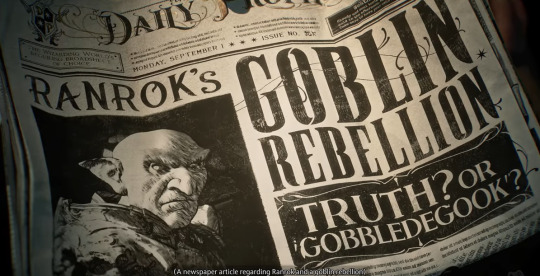
was captured with something like this:


and put to paper likely using a variation of halftone or photogravure; woodcut could do, too.
I'm not overly familiar with the contemporary printing techniques. Will read on them.
Today, organising a set-up like this isn't impossible even if you take your photos with the authentic cameras from two centuries ago. But how was it for people living back then?
I went very in-depth and in-detail. It is needed to draw a picture, or an approximation of it, before I can theorise anything about the wizards. I have a headcanon, yes, but it is not easy to put to concise wording without an atrociously long exposition to the topic of the early photography.
So.
The technology being was it was—crude at the wee hours of its dawn—left many to their own devices. Organising the process and getting the materials and the room, as well as the fact many photographers processed their photos themselves, rendered photography quite a prosperous business venue—if you could afford everything needed for it and could keep up with both the demand of a client and the process itself. It was ridiculously tiresome and hazardous, cumbrous even for something so monotonous and simple.
Besides, early photography was also notoriously long. Anywhere from few seconds to nearly an hour, depending on the intensity of the light and whether if you had fallen asleep or yawned or shuddered.
Hours long exposition was the thing in the landscape photography, that includes city photography. By today's standards, 5 seconds is a lot. But in the 1800s, it would've been considered incredibly quick!
Early techniques used photosensitive materials of poor sensitivity. This is why you'd commonly spend around few minutes before the camera lens: light needed to leave strong enough impression on the plate.
The main source of light was the Sun. Just making windows larger was not enough. The entire room was transformed or constructed in a form of a greenhouse to accommodate the camera's design and the plate's poor light-catching qualities. This set-up, established in the 1840s followed the overwhelming popularity of the daguerrotypes, had remained barely touched or changed until the 1860s.
Usually, it would something like this:

Obvious it is that the working process was dictated by the weather. Inconvenient, to say the least, and bankruptcy for an average brit. Exposure time was also, as I said, long. Long. Up to 30 minutes long.
Up to 30 minuted in the direct sunlight put through glass. People tanned while taking photos sometimes. If you've wondered why people on the old photos are uncanny and serious, this is one of the reasons why. In addition to that, if you move after the exposure has been set…
Long-exposure photos are quite popular today. You can use longer exposure to create effects like motion blur and many others.
Few examples, (c) Boarsart:
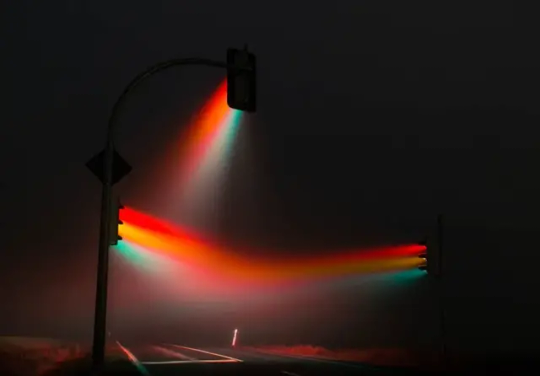



Allow yours truly to contribute to the bit with this crappy shot of the mouse light shaken near the lens:

But if you are shooting a single family portrait for 30 minutes straight (and nobody can move), any such effect will be catastrophic. It is not as much of an issue for the photographies recorded in film (by the time it is film, the photos are also taken much faster) but if you are making a daguerreotype—you are going to ruin it.
By the way: the "ghosts" on the photographs are caused by this effect. How it happens? Imagine exposure not only as gathering light thing, but as layering with transparent paints except you are also able to layer light on top of dark—because it's light theory, not colour theory. Anything you add to the solid foundation will be translucent. Therefore, if you have appeared mid-shoot, your figure would appear ghostly on the final photo—or not seen at all if your clothes blend with the background too much.
But don't worry. People couldn't give in into the slumber for long. To keep them straight and well-posed, other people invented yet another Victorian torture device: head-rests!



These beasts weighed tens of kilograms and had to be moved and recalibrated to fit each new customer manually. People were quite afraid of these things, hence the caricature from above (I believe, it's from Punch?). To shorten the exposure time, some photographers even applied white powders, like flour, on their clients' faces, as white reflects most light, therefore, it appears brighter. Can also explain the Perfect Skin people from the old photos often have.
Sitting underneath direct sunlight wasn't pleasant for the eyes either.
The photo room is commonly at the roof, has white or pastel-colour walls, and look much like a greenhouse. The light is blindingly bright. How to solve… this, somewhat, at least? Install blue-tinted windows! It's actinic anyway—meaning, affecting the photochemical reaction—and the daguerrotype plate is sensitive to light at the blue end of the spectrum, only barely affects the exposure time, and simultaneously keeps the client's eyes relatively unstrained. Don't worry though, they could blink. If you are supposed to sit before a camera for more than even 5 seconds, a blink wouldn't be registered. It's too fast to catch.
Atrocious exposure times were also the reason why people preferred to sit during the shooting.
By the time it's 1850s, something needed to change.
Sunlight was a terrible source of light. The entire work process is tied to the vagaries of the weather. Daguerrotypes, albeit photosensitive, weren't terrific at it at all. Not only that: they were hazardous. Fixing—the post-process, if you will—required the person working with the negatives to work with mercury vapours as it was the method of de-sentification the plates to light. As a result, many people died from the effects of the mercury poisoning in the years following the boom of daguerrotype photography. But it wasn't the main reason why the daguerrotypes were soon to be replaced with the ambrotypes and ferrotypes.
Underexposure was the deal-breaker for daguerrotype photography. It didn't solve this issue, nor offered solutions, neither was cheap enough to keep going. To make a plate for this kind of photography, you need an amalgam of (preferably) pure silver and copper or brass. It's too expensive in the long run. And it goes without saying to suppose it was a quest to replicate an image from the daguerrotype.
The replacement for it had already been introduced but but before the faster wet collodion methods, ambrotype and ferrotype, could take over (either was as sharp as the daguerrotype whilst requiring a lot less maintenance and possessing the duplicability of calotype), photographers needed to find sources of the artificial light.
Said light, however, with technology at hand, ought to be in the blue part of the spectrum. Anything like kerosene lamps—a very new thing at the time yet taking over the market at a rapid pace as it was the replacement for candles—couldn't be used; the light of the kerosene lamp is in the red part of the spectrum.
Photographers tried candlelight. Weak and insufficient source of light. Some tried the Drummond light—limelight—as it was super bright and was widely used in theaters and music halls. At the start of the 19th century some even suggested to use it for street illumination but… This is how the limelight looks like:


A piece of calcium carbonate, usually in cylindrical form, is skewered on the thin rod on top. To make it candescent, flame was required, and was put directly at the piece whilst it has been continuously rotated. Besides, the piece was not burning away evenly and required an abysmal amount hydrogen gas. You can change it for the coal gas, also known as the town gas, or for acetylene. Either way, you are stuck with a highly flammable and agressive chemical reaction.
The size of the piece was also a huge problem. It was too big to be safely and effectively utilised for this purpose. Look at the packaging:
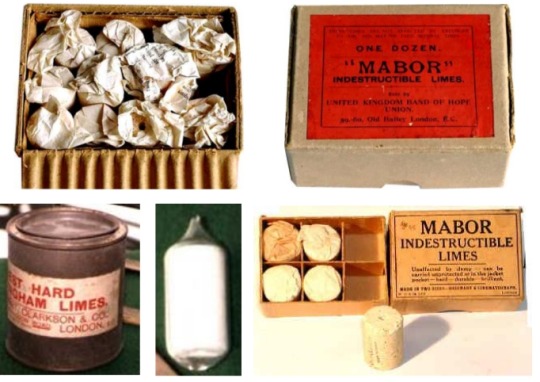

So. The limelight is expensive. Needed additional pair of hands. Could engulf the entire studio with uncontrollable flames and take down the entire building with it—not to mention mercury. You don't want mercury vapours raw—and certainly don't desire them travelling around the city block trapped in a thick cloud of smoke.
The photographs made with the limelight were overexposed and had "chalky" look to them. Photographers couldn't really stick to it. Yet, it was used occasionally up until the 1860s because it was still light and the clients have paid for the session.
If you had ever seen or felt the intensity of a scoop light, limelights are as blinding. Daylight or this, for so a lot of decades, was the only choice besides the option of refusing to make photo of themselves for many people (it sounds quite dramatic; taking a photo wasn't formidably expensive for most people but depended on the kind of the technology involved; the daguerrotype would be more expensive (silver) than an ambrotype (glass) or a ferrotype (iron sheet), or a calotype (paper)).
There were other attempts to introduce chemical sources of light to the process but neither could provide the necessary amount of blue, nor they were sufficient light sources.
I have mentioned 1860s a few times. What happens in the 1860s?
The invention of magnesium wire.
Its light is highly actinic and it's continuous. Magnesium wires were used to take photos of the catacombs of Rome in the late 1860s—to give an indication of just how bright they can be:

It was the breakthrough.
But magnesium introduced few new troubles. First off, staring at the wire could hurt the eyes. Second, the wire was prone to fuming and snuffing itself; dousing it in water could cause it to burn even brighter due to the reaction with hydrogen in the water's vapour. Thirdly, that thing blasted like gunshots.
It is then when you see the change in postures on the old photos, too. People could stand! (c) photos. A jardinière becomes a Very Important Decorum:

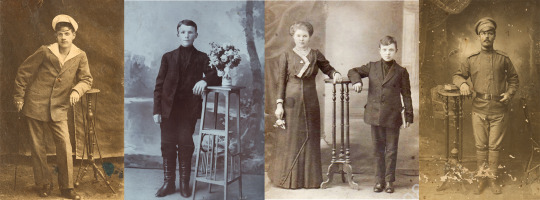
Flattening the wire, developing the special casings for it, performing the shooting in synch with the burning helped a bit but now it was too much uncontrollable light.
To mitigate this whilst still providing enough lux, magnesium flash was developed after the few years of unsuccessful tries. We know this flash under another name: the flash-powder.
It was usually a mix of potassium perchlorate and magnesium, but PP could've been replaced with 1) nitrates of barium, thorium, or ammonium, 2) or with potassium permanganate. Sometimes, sulfur was added (you don't want to do that, it's not gunpowder!!!).
If you supposed the new solution introduced storage complications, spontaneous combustion and smoke clouds enshrouding the sitters, you are most correct. Photographers were granted mobility in their work to escape dinner parties before guests could realise their gowns and food were coated in grime. The flash itself was also quite loud:
youtube
The flash-powder had remained in use until well into the 1960s.
Cheap, quick, serving its purpose well until electric flashes eventually came to replace it. Albeit, the flash gives a very soft light; we struggle to replicate it with safer alternatives today, believe it or not.
Flash-powder was also a cheaper option between it and the flashbulb used in the analog cameras we know circa 1930. The bulb had been rapidly modified and worked on since, as the first examples of this technology were single-use items. And, you know. Flashbulbs.
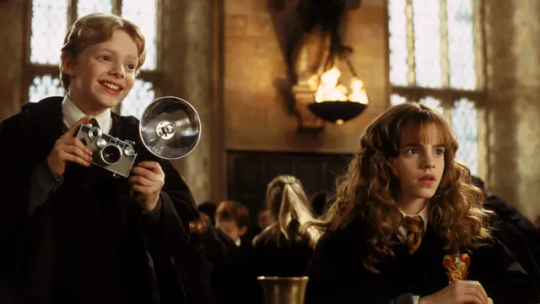
Colin's camera is an indication that analog cameras can be used in the wizarding world. Especially the older cameras, the box-n'-box, something like Thornton Pickard, Houghton's Midg or the Brownie.
All of these use something called gelatin silver print as a unit of storage—in other, more familiar words, it is the Kodak film we all know and remember (hopefully; please tell me we are all old farts).
It was lousy of me not to mention what were exactly these many -types of photography and photographs. They are all based on the two discoveries that made photography even possible: 1) camera obscura that has been known c.5 century B.C. and 2) photosensitivity of the silver nitrate (when powdered and exposed to sun, turns black as ink), discovered in 1614 by Angelo Sala. So, what are these:
1839-1856: daguerrotypes. Required polished-to-mirror-finish sheets of silver-platted copper or brass. Needed to be exposed to a source of light, could take seconds, could claim tens of minutes. The latent image is only visible when exposed to mercury vapours for a few minutes; could've been entirely avoided by exposing the plates to the sun after covering them with red or yellow colour filter but was rarely if at all done due to the process taking at least a day. Besides, the image could appear as both negative and positive if viewed at different angles but only under specific light. Fixing is done by a rinsing with fixer and and in auric chloride. The plate is then sealed behind glass. Expensive and lengthy process.
1856-mid1860s: ambrotype. Glass plate is the base material. One side is coated with a thin layer of collodion and then dipped in the silver nitrate—so it will stick to the glass. Then the plate is exposed for a time necessary, but quick enough to avoid over-exposition or drying. Remove, develop, fix. The back of the ambrotype image was usually covered with something black: lacquer or cloth—done to highlight the opaque areas that appear lighter when viewed against the dark background. The glass used could be tinted. The resulting negative is always positive image and can be seen under any light. Cheaper and slightly shorter in comparison.
1860s-mid1950s: ferrotype. Basically, ambrotype, but the base material is a thin sheet of iron. Eventually, replaced ambrotype photography due to the flaking of the ambrotype images. Before the glass for ambrotype would be ready, it required a thorough cleaning to degrease it. Iron for a ferrotype was a lot easier to prepare, it was faster to shoot with, to fix and develop it and seal the resulting image. All could take just few minutes. Inexpensive and fast option.
1890s—nowadays: kodak film gelatin silver print. Insanely long-lasting, incredibly photosensitive, an absolute winner.
Essentially, all use silver and a some kind of emulsion to stabilise it for a period of time, enough to capture something. Now that I wrote all this,
my headcanon.
Wizarding photography as we know it really took off only after the flash-powder was made. In muggle photography, the flash creates enough light to leave an impression.
Wizards are different. They do not capture light. Instead, they expose a kind of unit of storage but for magic readings and call it exposure.
Too much magical impression—which I can characterise as nothing less than magical residue left by any soul and particle of the universe—"corrupts" the film. This is why magical photography is usually few seconds long, but can also act like a normal magical painting. Sometimes.
So, why using the flash?
It blinds the magic. It is also too much magic. An overload or better say, over-exposition. The first ever photo made with the flash was thought to be ruined but…
Magnesium is an element alchemists supposed being able to burn if not forever, then persistently. They also thought it was used in the process of making the Philosopher's Stone. What if you add sulphur to it, too?
The magic has been rejuvenated but kept repeats itself an infinite number of times after has been hit with a sulfur-magnesium flash; it's imposed a some kind of self-circuiting behaviour that allows it to just flash the same scene over and over again. It is persistent, at least.
phew
That should be all. I might return to this post to review it in the future and maybe clean up details here and there and add clarity. Hope it was informative. Oh and there was a guy in 1901. He was measuring the heights of the Moon's mountains. I forgot to mention.
14 notes
·
View notes
Text
#782: Faculty Tower Breakdown
This one post is going to be small but very special to me. ^ ^
For quite some time, months I'll say, I've been wondering about how the castle's inside matches its outside. Where are the windows of professors' rooms? How to spot less obvious locations from outside the walls? Not at all a full comprehensive guide but still might be a helpful tip to the Slice of Life authors or anybody curious out there.
We'll start with a tidbit of my House — The Ravenclaw Tower.
The post has obnoxious amount of pictures.
Apologies for funny handwriting.
As you can see, the tower has floors for each year but only 4 of the 7 are accessible in-game. Floor plaques are also differently placed (6th year floor being reserved for the 5th year students) and you'd have to use imagination to fit in the bathrooms.


Ravenclaw Tower overlooks the Faculty Tower. Roughly put together, the most notable locations of the Tower are these:
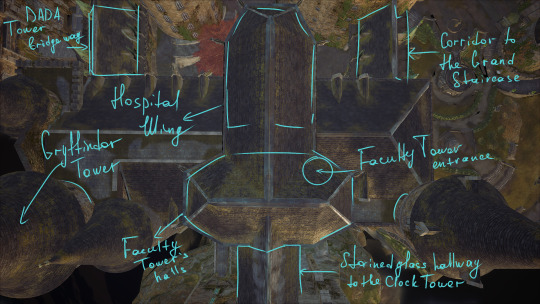
To put it all into a perspective that is likely to be seen in-game: the view from an archway leading out to the Entrance Hall courtyard.

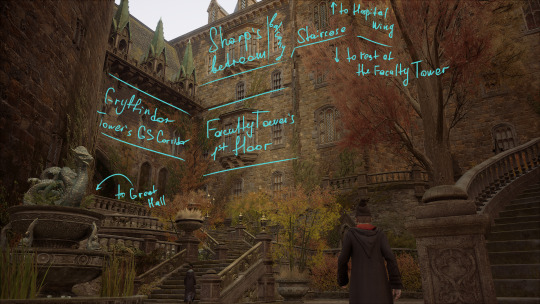
As you can see, first floor staff gathering could oversee the Quad courtyard through the erker— oriel window. Professor Sharp has one as well but his view might be obstructed and limited due to its height.
Here's what our lovely Potions master could see through the oriel window:
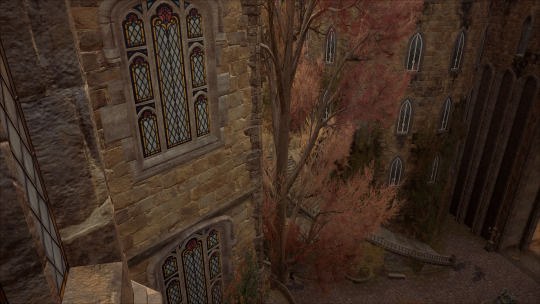
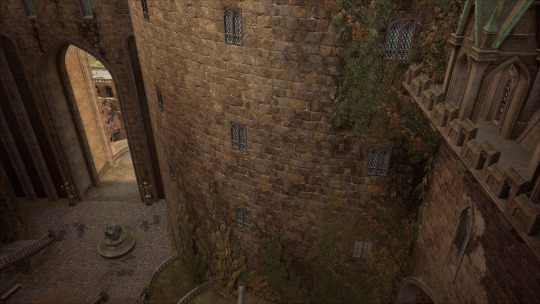
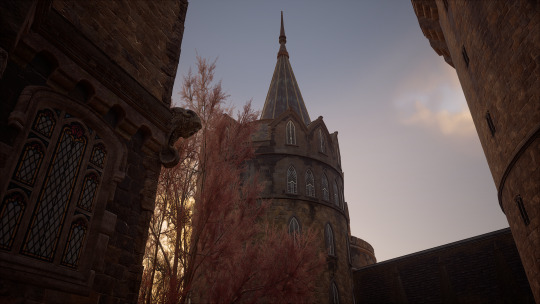
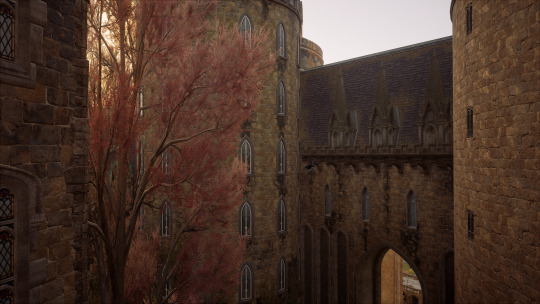
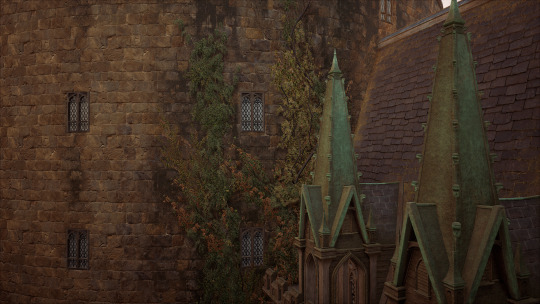

And here is what he could see through the other window:
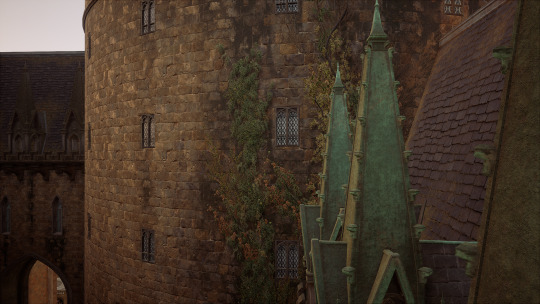
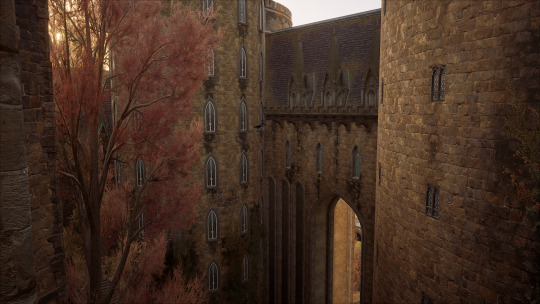
Hogwarts is easy to navigate outside by its windows. Each location has different kind and form of windows — or non at at all but that bit is for another day (if anybody is interested in a little continuation).
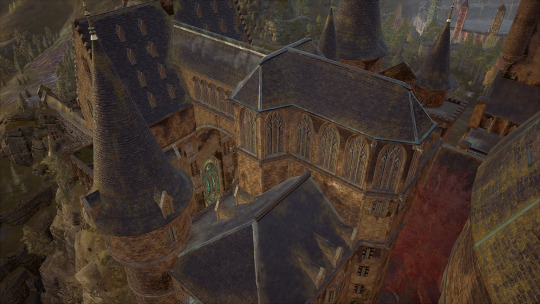
The wall of five closely put triple lancet windows seen conjoining the Clock Tower is the passageway seen outside the Hospital Wing:

Windows of the Hospital Wing are also very distinct by the sheer size and match the ~30 degree angle of the outer wall:
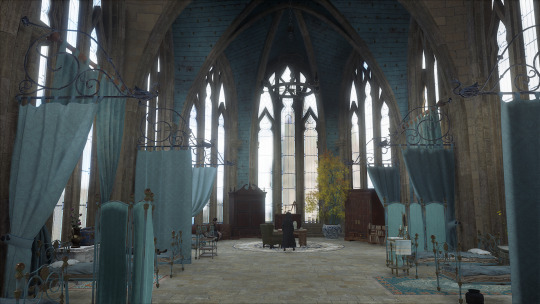
With a little bit of Ansel magic, we can with all certainty tell that the Prefects Bathroom is directly underneath the Hospital Wing:

And is located on the same level as the lower part of the passageway to the Clock Tower.
Knowing this, we can go down the helix, that is around the centre part of the Tower, and found ourselves here:
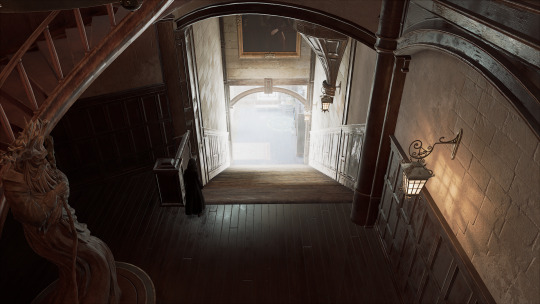
Down the stairs are Sharp's private quarters (if you scroll up to the Quad Courtyard pictures you'll notice 'balcony'; I was referring to this place specifically) and the same wall Hospital Wing, Prefects Bathroom and the Faculty Tower Staircase are facing.
Here is the better show of the area outside:
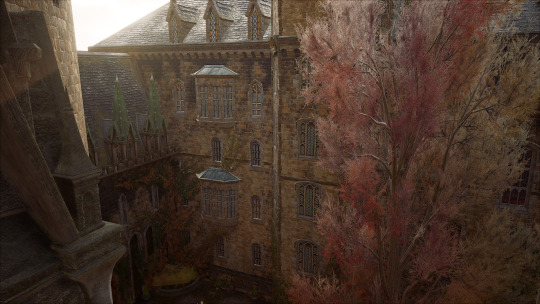
and from the inside:

Sharp's windows:
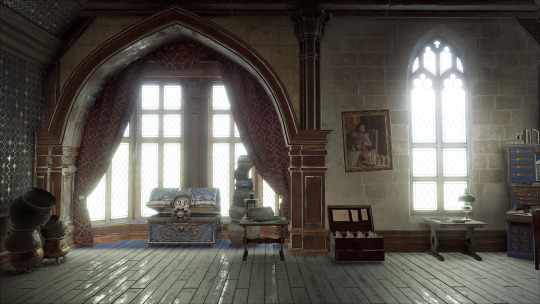
Bits of magic again to better understand the room's placement; interesting thing to notice: 1) Sharp's fireplace doesn't have functioning chimney at all; 2) his art room is directly above his bedroom; 3) the lower oriel window is the Faculty Tower's hall, meeting hall? Whatever; those two out-of-place windows are the ones on the floor where you can find Professor Onai and Professor Ronen's rooms.
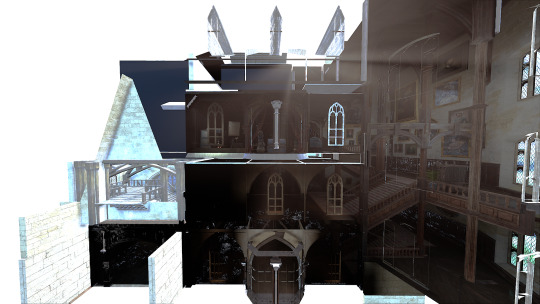

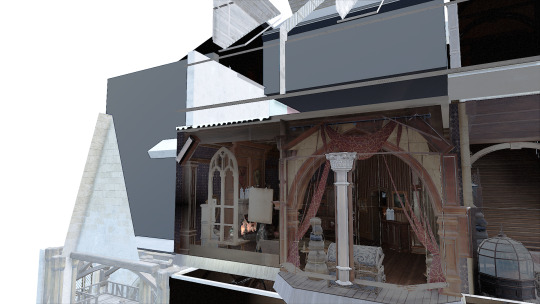

Speaking of which.
Rooms of said professors 1) don't have any windows, 2) share a wall, 3) and both share a wall to the corridor leading to Gryffindor Common Room:

If you remember, Professor McGonagall could hear Gryffindor partying behind the wall of her chambers. 🤭
Underneath the floor are Professor Fig and Professor Garlic's chambers:

A better look on the windows in professors' bedrooms:



If you think something doesn't add up on that wall, it is. The lower part isn't displaying the helix on the right correctly; the windows should've been following the curve of the stairs. I would attach the pictures proving it but only 30 are allowed per post so. .—.
Tags: @gufu-vire @thriftstorebabayaga @phinik-nonw @muzzzzle
I'm totally sane about this game. ^ ^
#днявочка#днявочка: hlegacy#днявочка: игры#hogwarts inquires#eng tag#hogwarts legacy#aesop sharp#eleazar fig
62 notes
·
View notes
Text
#1600
what one wouldnt do to write right into the workskin on ao3

5 notes
·
View notes
Text
#1512
i will not fanon anything about the colours magic supposed to have having anything to do with the rivers of the greek underworld i will not no bad brain i said

6 notes
·
View notes
Text
#1617
I had a feeling that the Director's Cut was going to be cancelled.
The devs did tell there wouldn't be a DLC, I recall, so it was… a tad bit strange to hear about a whole director's cut churning.
The term Director's Cut is passed down from the film industry. There it means that the film's director wasn't satisfied with the final cut for whatever reason, and released their own version. It is usually longer and/or include cut scenes, may have some scenes in a different order and many other things the director thought were needed or couldn't fit in for the OG release.
In the gaming industry, DC usually means an overpriced lacklustre DLC, and is only rarely a huge update e.g. Discо Elysium: The Final Cut.
I wouldn't say I am not sad. I had a glimmer of hope that they will add more to the game—but from what they had to scrape during the development process, and not create anew. To the *new* content, I'm indifferent.
#днявочка#eng tag#днявочка: hlegacy#i said it before i will say it again: i dont want new content for hl. i want something that has been already created added to the game#i dont need it in a sequel either—i need this game to be polished. it is not an unreasonable demand; cbр77 is the perfect example of wim
4 notes
·
View notes
Text
#1565
j*k*r mentioned that wizarding folk don't struggle with muggle deceases. that it doesn't really affect them even. i find it hard to believe but you also know me: i'm not a fan of midi-chlorians
in my mind, they absolutely catch influenza or cold or any other decease. it may not lead them to the grave but still, their immune reaction—enhanced with the will to get well aka magic—forces them to experience flares of fever and mind-numbing trans-like state.
it may also compromise their immune systems. im calling it a wip for now
4 notes
·
View notes
Text
#1499
flew over the rookwood castle
i thought korrow ruins were a strange castle, but this one takes the cake. it doesnt cover the perimeter of the rock it sits on, there are two perfect access points besides the gate and behind the castle is a perfect place for a siege camp. its irl counterpart, the chepstow castle, hasnt these weaknessess
4 notes
·
View notes
Text
#795: DADA Tower Breakdown - 1
I was planning the breakdown for a later date but seeing many of you interested in this kind of meta posts put me in excitement haste, ngl.
Link to the previous post. Let's go!
Tumblr sets a strict limit on how many images it allows per post, 30, so I decided to divide the breakdown into 2 parts:
Part 1 - Transfiguration Courtyard || Part 2 - DADA Tower
Without further ado, a brief explanation on how do I determine the classes placement: windows and window patterns.
For example, Transfiguration class:
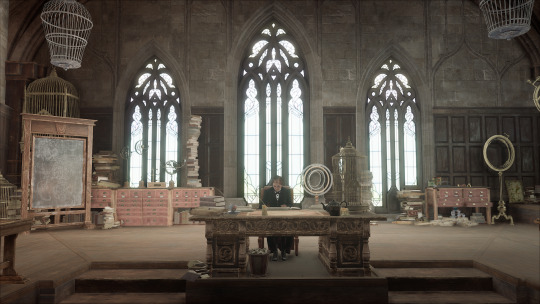

For fellow slice of life authors around here, I'd like to note: the class should be somewhat dim or even dark during certain hours of day.
Potions class:
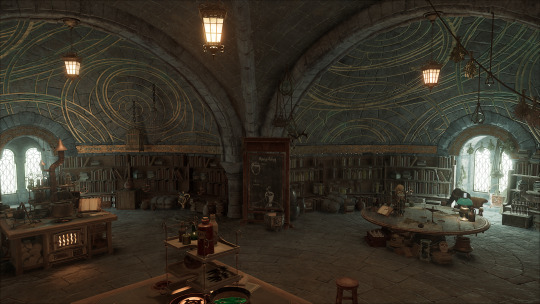
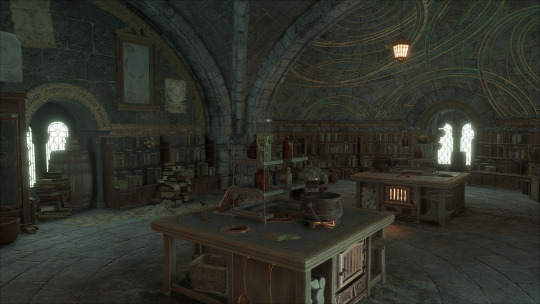
Each of the 7 vaulted alcoves have a window at one of the edges (is it a correct word for a dome-shaped room?). However, if you venture outside and hop on the broom near the widow statute, you'll see only a wall, a rock, and a lone window near the Slytherin common room:

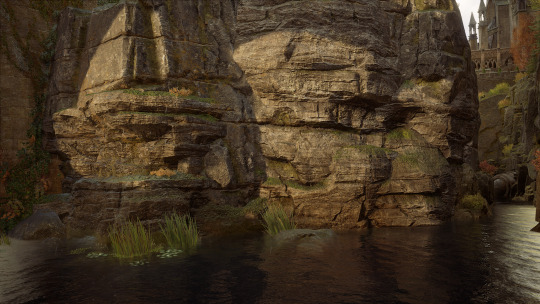
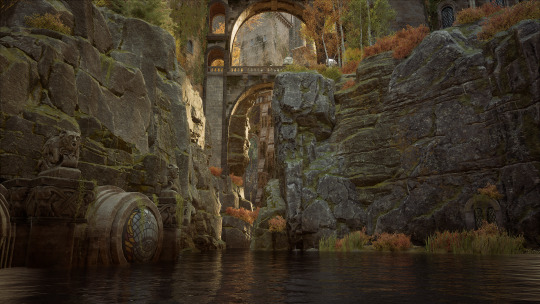
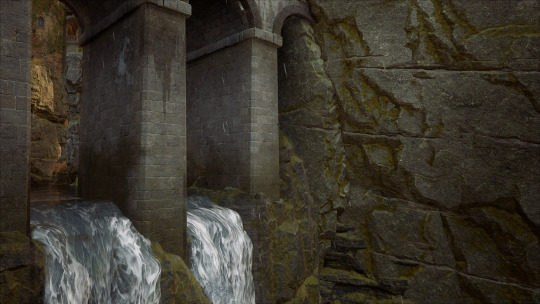
The window seen is the one behind Sharp's desk:
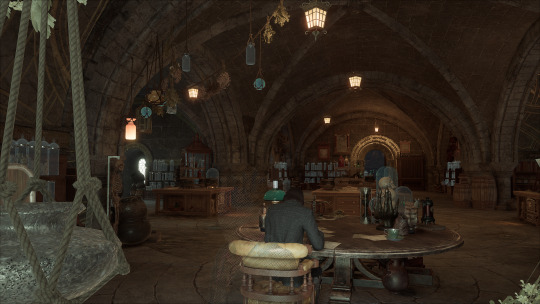

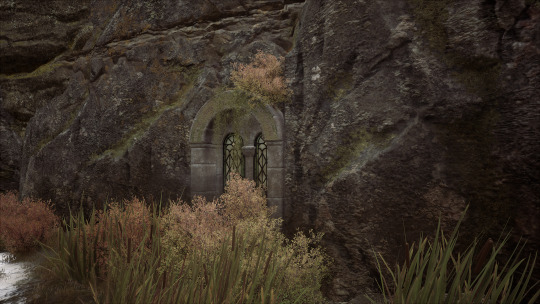
As a bonus of sorts, this is Hogwarts Library windows:
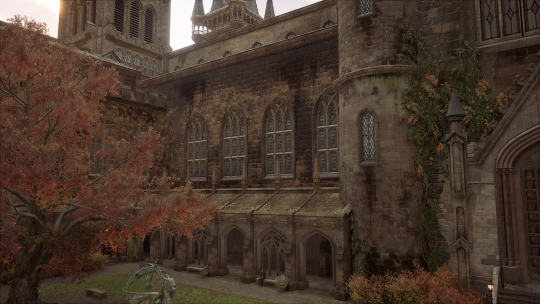
And this curious set of windows:
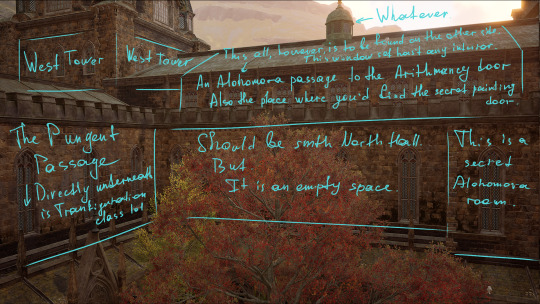
This the empty space on the second floor:
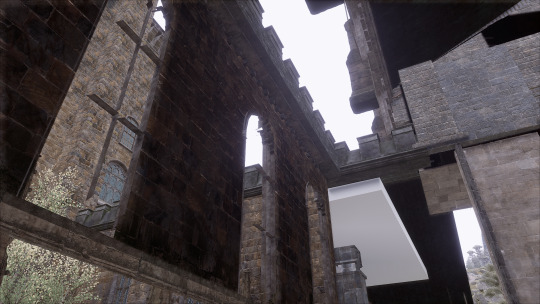
Windows of the Pungent passage when you face the DADA Tower entrance:

This cosy little place is Alohomora door in the Courtyard:
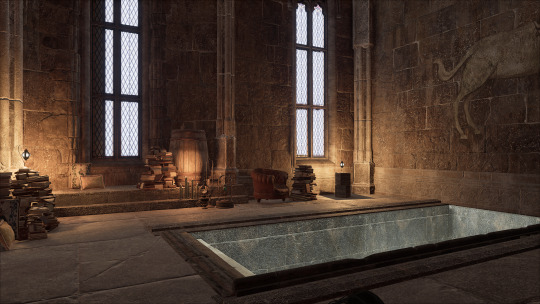
The Alohomora passage is the corridor at the opposite side from the door to the Music room:

Its windows match the exterior shown above, however, the window row facing Transfiguration Courtyard is empty space:

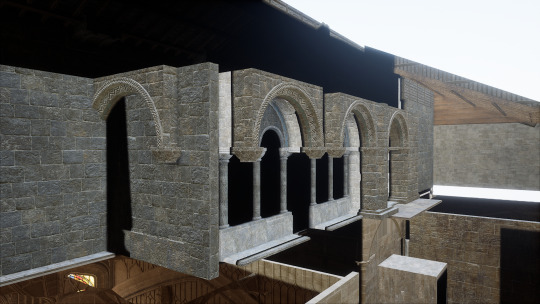
Corridor windows face the other side, the Pitch and Kogawa's lawn:
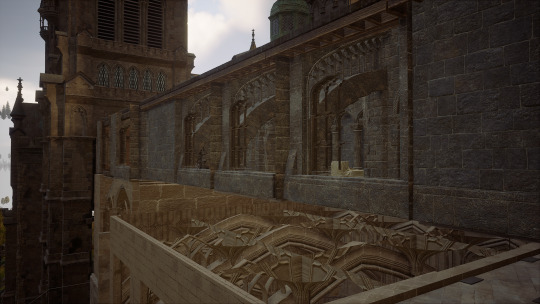

>>> Part 2
tags: @endeavour12345 @phinik-nonw @thriftstorebabayaga
#днявочка#hogwarts legacy#hogwarts inquires#aesop sharp#eng tag#hogwarts legacy mc#matilda weasley#днявочка: hlegacy#днявочка: игры
32 notes
·
View notes
Text
#593: Potions Class Chalkboards
I am replaying the game and was thinking of a fairly recent post made about boards in the Undercroft and in the Skriptorium. Potions class has its own set of boards and frankly I'll wheeze out my soul if the handwriting on some of these belongs to Sharp, istg.



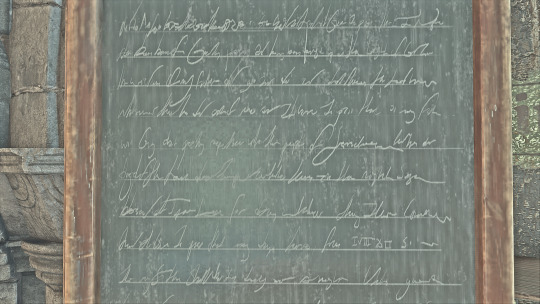

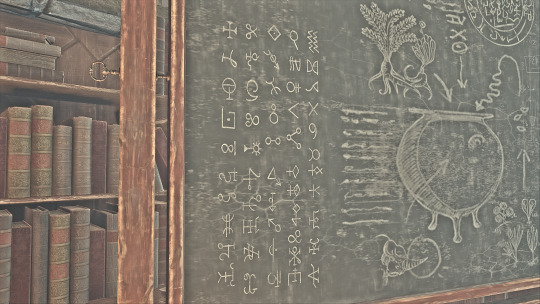

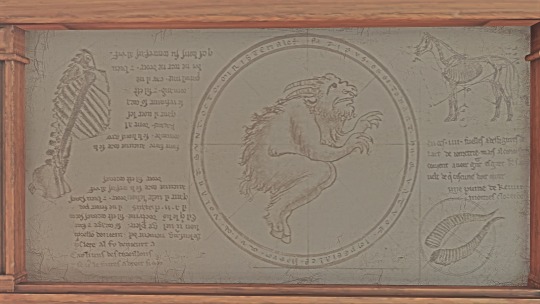
I wonder what those symbols mean in a sentence (if to assume it is a cipher of sorts and not just gibberish). Some are astronomical symbols, some alchemical; the last one (hangs inside Sharp's office) is written in Latin, I suppose?..
More images below the cut.
Throwing in these again:

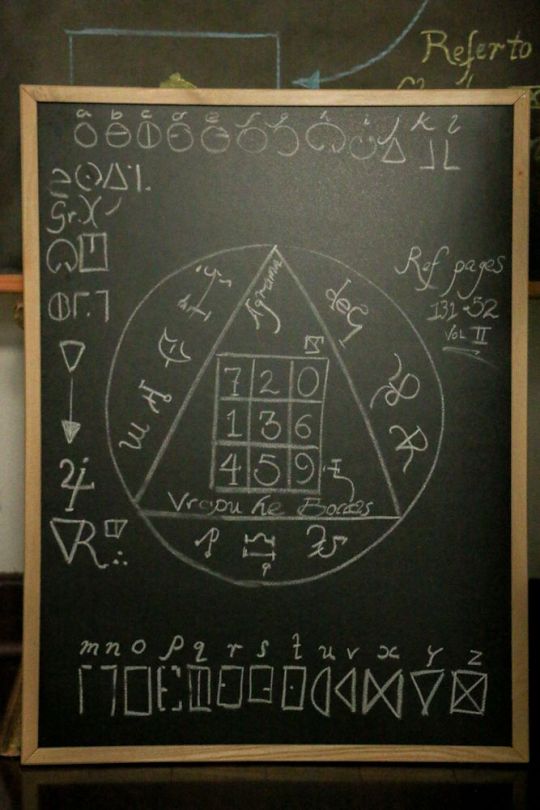

Remember the werewolf post?
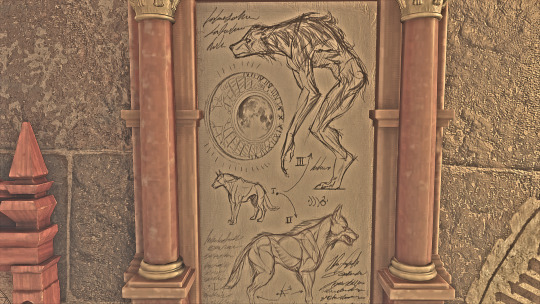
Another two panels:
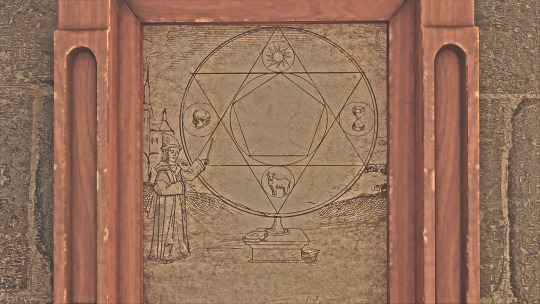

#днявочка#днявочка: hlegacy#hogwarts legacy#hogwarts inquires#днявочка: фандомное#eng tag#днявочка: игры#aesop sharp#professor sharp#wizarding world
41 notes
·
View notes
Text
#731
more @phinik's aesop <3


26 notes
·
View notes
Text
#1573
sticking to gold and silver — and, potentially, to platinum, mercury, copper, lead, iron, and tin — feels a little weird for the wizworld's economy. why those? why not dragon hearts or wood or any other rare and precious resource for the base for the economy?
besides, it's not just gold or silver or copper. it's goblin metal work — galleons, sickles, and knuts — that has an intrinsic kind of value.
but anyway. and bear with me.
gold and other metals might be replicable with spells or alchemy but magic used in the creation of magical currency isn't. it can only be cast — by the goblins or other creatures; so far, we've only heard of the british bank but not french, dutch, german, russiаn, or any other, so other regions may have their own currencies.
unlike of woods or animal parts, metals tarnish but not wither. it's always possible to remake the old coins, too, but they must be ensigned with magic.
why?
medieval scholars couldnt create gold from nothing, hence the common assumption money couldn't be created as well; something similar is likely existing in hp as well. modern money is a thin sheet of coloured paper with glinting watermarks and precarious fiber alignment, however. it can be replicated by magic within the lore of the hp universe.
this counterfeiting will be glaringly obvious but if you're a savvy or generally acute wizard, you'll remember to change series number on the bills or try to randomise them, in addition to changing few other bits. money aren't spells in the muggle world. a curious transfiguration project, though, but not an impossible one.
so are the replication of the precious metals.
but you absolutely can't replicate the exact magic from nothing.
why?
magic doesn't require verbal incantations or wand-movements; these are mnemonic techniques developed for the ease-of-use and ease-of-learning, if you will. whilst essentially, your spell is a unique, your own, truly belonging to you understanding of what the spell should perform or do. it can't be replicated by someone else as in, you can't create a flippendo on all atomic levels it perturbs in order to flip or push an object or a human; you're not replicating an exact thought of the caster.
perhaps this is what the gamp's law of elemental transfiguration is about. you can't clone life — you can't replicate the precise tampering that is cooking or any other process — and you can't replicate magic.
you can only snapshot a stage of entropic process but not the chaos of creation or ongoing. this is why the goblins gold is protected by-design — this is why it has become the currency — that's why goblins are essential to the model of their economy.
4 notes
·
View notes
Text
#729
AAAHHHHHHHHH @phinik DID IT AGAINNNNNNNN sharp's side profile incoming!!









@boxdstars @thriftstorebabayaga

24 notes
·
View notes
Text
#1559
I think, the snitch appointing whole 150 points when the quaffle earns 10 is quite unfair.
In order to win the match, the opposing team must score 160 points until the snitch is caught, and also don't allow you to score at all. Otherwise it's a complicated and exasperating math.
I can't imagine this being a very easy or entertaining task to marvel at. Constant scoring will wear down your goalie, giving an unfair advantage to the opposing team. Quaffle never leaving the goal also feels like a weird sport—you watch as rings at the one side of the field have all shots. If the quaffle reappears at the centrefield after each goal—well, uh, the sport will be a drag. Not to mention the snitch also ends the match and is released right at the start of the game.
It also prompts teams to either train as primary chasers or primary seekers. You would have two different sports within a sport, so it feels best if you split them into dedicated categories rather than combine into an one disaster where chasers are important but not as important as a seeker whilst the seeker is practically a useless player, if only to end the match.
My thoughts on how to balance out:
My initial thought: chasing and seeking are different skills and shouldn't be so intermingled as they are canonically. Chasers play for little amounts of points, so, logically, they must be the spectacle of the match and focus on manoeuvrability and power play. Their general play style is grinding numbers and look cool while performing goals. Seekers, at the other hand, should be lightning fast and play off reflexes, besides, they end the match. They should appear just at the right moment, yet how to make the moment cathartic is a great question. Perhaps it should only be answered on the pitch rather than heavily theorisied. Quidditch is a team sport, too, so the seeker should not catch the snitch whenever they please. They should time it with the chasers; it implies there should be no such thing as 150 for the snitch. Both gameplays should be split, otherwise the show is either you watch chasers or you eye seekers. That should not happen. Why though? Chasers do an insane amount of work but all credit goes to the seekers as they end the matches with an overwhelming score difference. It can be argued that the teams should just grind faster or catch the snitch sooner, but it's all, again, about the seekers.
So, what I suggest:
Snitch is zero points but ends the game. Can grant a victory after had been caught before the score changes from being even (e.g. 0:0, 10:10, 130:130, and so on), so it must be timed with the chasers but also prompts seekers to eye the snitch. The leading team's seeker has an incentive to catch the snitch sooner, so another seeker must play tricks or rely on the beaters to distract said seeker. Also gives the beaters a substantial role: they create obstacles for the seekers rather than try to disrupt their grinders that are the chasers.
Snitch is released after one of the team scores 100. Caught snitch evens the score and begins the Golden Goal phase. First team to score wins. In this case, chasers have a lot more attention to them than the seekers.
Snitch is released at the start of the game. Ends the game, if caught. Earns 10 points. These 10 points can be pivotal so the chasers must grind to the highest score and seekers must time the catch, otherwise they will end the game but lose the match.
I also want to underline the difference in their plays. Chasers are more skill-based role whilst seekers must also rely on their luck.
2 notes
·
View notes
Text
#750: merlin's beard ELEAZAR
this audio is a gem. sad they didn't leave it in.
youtube
#днявочка#днявочка: hlegacy#днявочка: игры#eng tag#hogwarts legacy#eleazar fig#aesop sharp#phineas nigellus black#hogwarts legacy mc#im wheezing#please give it a listen#Youtube
36 notes
·
View notes